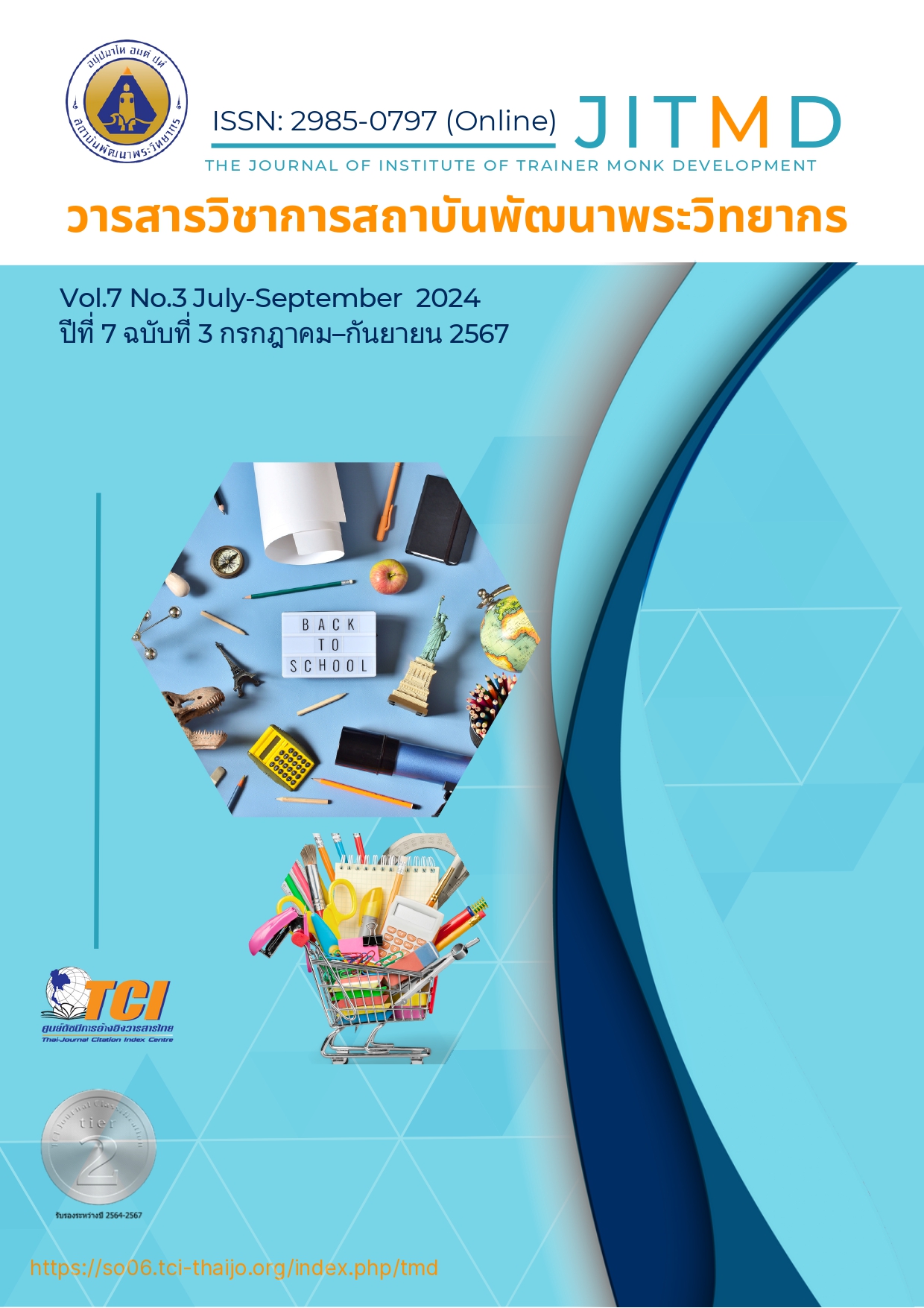The Relationship Between Administrators Strategic Leadership and Teamworking of Staffs in Phatthalung Office of Learning Encouragement
Main Article Content
Abstract
This research aims to 1) to study the strategic leadership of educational administrators under the jurisdiction of the Pattalung Provincial Office of Learning Encouragement, 2) to study the teamwork of personnel under the jurisdiction of the Pattalung Provincial Office of Learning Encouragement, and 3) to study the relationship between strategic leadership and teamwork of personnel under the jurisdiction of the Pattalung Provincial Office of Learning Encouragement. The sample group consists of 103 personnel from all 11 districts of the Pattalung Provincial Office of Learning Encouragement who are working in the fiscal year 2023. The sample size was determined using the Krejcie and Morgan table and the proportions were compared according to the district. The sample was then randomly selected using the simple random sampling method by drawing lots without replacement. The instruments used to collect data were questionnaires. The statistics used were frequency, percentage, mean, standard deviation, and Pearson correlation coefficient. The results of the study found that 1) the strategic leadership and teamwork of personnel under the jurisdiction of the Pattalung Provincial Office of Learning Encouragement were at a high level overall. When considering each aspect, it was found that the aspect with the highest mean score was the ability to use various input factors to determine strategies, followed by the aspect of revolutionary thinking, and the aspect of high-level thinking and understanding. The aspect with the lowest mean score was the aspect of having expectations and creating opportunities for the future. 2) the teamwork of personnel under the jurisdiction of the Pattalung Provincial Office of Learning Encouragement was at the highest level overall. When considering each aspect, it was found that the aspect with the highest mean score was communication, followed by coordination and cooperation. The aspect with the lowest mean score was continuous improvement. 3) the strategic leadership of educational administrators was significantly positively correlated at a very high level with the teamwork of personnel under the jurisdiction of the Pattalung Provincial Office of Learning Encouragement at a statistical significance level of .01.
Article Details

This work is licensed under a Creative Commons Attribution-NonCommercial-NoDerivatives 4.0 International License.
บทความที่ได้รับการตีพิมพ์เป็นลิขสิทธิ์ของวารสารวิชาการสถาบันพัฒนาพระวิทยากร
ข้อความที่ปรากฎอยู่ในบทความที่ได้รับการตีพิมพ์ในวารสาร ถือเป็นความรับผิดชอบของผู้เขียนบทความ และข้อคิดเห็นนั้นไม่ถือว่าเป็นทัศนะและความรับผิดชอบของกองบรรณาธิการวารสารวิชาการสถาบันพัฒนาพระวิทยากร
References
ชาญชัย อาจินสมาจาร. (2550). ทักษะภาวะผู้นํา. กรุงเทพฯ: มัลติอินฟอร์เมชันเทคโนโลยี.
ญาณินี พหุพันธ์. (2564). “ความสัมพันธ์ระหว่างภาวะผู้นำเชิงกลยุทธ์ของผู้บริหารสถานศึกษากับ การทำงานเป็นทีมของบุคลากรในสังกัด สำนักงานส่งเสริมการศึกษานอกระบบและ การศึกษาตามอัธยาศัย กลุ่มสมุทรคีรี”. วิทยานิพนธ์ปริญญาศึกษาศาสตรมหาบัณฑิต. สาขาวิชาการบริหารการศึกษา. มหาวิทยาลัยธนบุรี.
ทรรศนะ บุญขวัญ. (2549). ภาวะผู้นําเชิงกลยุทธ์. กรุงเทพฯ: มหาวิทยาลัยหอการค้าไทย.
เนตร์พัณณา ยาวิราช. (2550). การจัดการสมัยใหม่. (พิมพ์ครั้งที่ 6). กรุงเทพฯ: ทริปเพิ้ล กรุ๊ป.
บุญชม ศรีสะอาด. (2545). การวิจัยเบื้องต้น. (พิมพ์ครั้งที่ 7). กรุงเทพฯ: สุวีริยาสาส์น.
พรนพ พุกกะพันธุ์. (2544). ภาวะผู้นำและการจูงใจ. กรุงเทพฯ: โรงพิมพ์จามจุรีโปรดักท์.
พระราชบัญญัติส่งเสริมการเรียนรู้. (2566). สืบค้นข้อมูลเมื่อวันที่ 2 ตุลาคม 2566 จาก https://ratchakitcha.soc.go.th/documents/140A020N0000000006000.pdf
วิรันทร์รัตน์ เสือจอย. (2564). ภาวะผู้นำเชิงกลยุทธ์ของผู้บริหารสถานศึกษาที่ส่งผลต่อคุณภาพ ผู้เรียนของโรงเรียน สังกัดสำนักงานเขตพื้นที่การศึกษามัธยมศึกษาสิงห์บุรีอ่างทอง.วิทยานิพนธ์การศึกษาตามหลักสูตรศึกษาศาสตรมหาบัณฑิต สาขาวิชาการบริหารการศึกษา. ภาควิชาการบริหารการศึกษา. บัณฑิตวิทยาลัย: มหาวิทยาลัยศิลปากร.
สุนันทา เลาหนันทน์. (2549). การสร้างทีมงาน. กรุงเทพฯ: แฮนด์เมดสติกเกอร์แอนด์ดีไซน์.
สุรัตน์ เปี่ยมศิริ (2563). “ภาวะผู้นำเชิงกลยุทธ์และประสิทธิผลการปฏิบัติงานของข้าราชการ สำนักงานเขตบางเขน”. สารนิพนธ์รัฐประศาสนศาสตรมหาบัณฑิต. บัณฑิตวิทยาลัย: มหาวิทยาลัยเกริก.
สุเทพ พงศ์ศรีวัฒน์. (2548). ภาวะผู้นําทฤษฎีและปฏิบัติ: ศาสตร์และศิลป์สู่ความเป็นผู้นําที่สมบูรณ์. กรุงเทพฯ: วิรัตน์เอ็ดดูเคชัน.
DuBrin, A. J. (2004). Leadership: Research findings practice and skills. (5th ed.). Boston, MA: Houghton Mifflin.
Romig, D. A. (1996). Break Through Teamwork: Outstanding Result using Structured Teamwork. Chicago, IL: Irwin.
Krejcie, R.V., & Morgan, D.W. (1970). Determining Sample Size for Research Activities. Educational and Psychological Measurement, (30)(3): 607-610.


